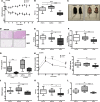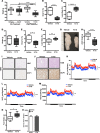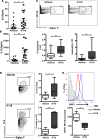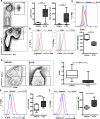A small-molecule inhibitor of SHIP1 reverses age- and diet-associated obesity and metabolic syndrome
- PMID: 27536730
- PMCID: PMC4985248
- DOI: 10.1172/jci.insight.88544
A small-molecule inhibitor of SHIP1 reverses age- and diet-associated obesity and metabolic syndrome
Abstract
Low-grade chronic inflammation is a key etiological phenomenon responsible for the initiation and perpetuation of obesity and diabetes. Novel therapeutic approaches that can specifically target inflammatory pathways are needed to avert this looming epidemic of metabolic disorders. Genetic and chemical inhibition of SH2-containing inositol 5' phosphatase 1 (SHIP1) has been associated with systemic expansion of immunoregulatory cells that promote a lean-body state; however, SHIP1 function in immunometabolism has never been assessed. This led us to investigate the role of SHIP1 in metabolic disorders during excess caloric intake in mice. Using a small-molecule inhibitor of SHIP1 (SHIPi), here we show that SHIPi treatment in mice significantly reduces body weight and fat content, improves control of blood glucose and insulin sensitivity, and increases energy expenditure, despite continued consumption of a high-fat diet. Additionally, SHIPi reduces age-associated fat in mice. We found that SHIPi treatment reverses diet-associated obesity by attenuating inflammation in the visceral adipose tissue (VAT). SHIPi treatment increases IL-4-producing eosinophils in VAT and consequently increases both alternatively activated macrophages and myeloid-derived suppressor cells. In addition, SHIPi decreases the number of IFN-γ-producing T cells and NK cells in VAT. Thus, SHIPi represents an approach that permits control of obesity and diet-induced metabolic syndrome without apparent toxicity.
Figures





Similar articles
-
Obesity control by SHIP inhibition requires pan-paralog inhibition and an intact eosinophil compartment.iScience. 2023 Jan 28;26(2):106071. doi: 10.1016/j.isci.2023.106071. eCollection 2023 Feb 17. iScience. 2023. PMID: 36818285 Free PMC article.
-
Coordinate expansion of murine hematopoietic and mesenchymal stem cell compartments by SHIPi.Stem Cells. 2015 Mar;33(3):848-58. doi: 10.1002/stem.1902. Stem Cells. 2015. PMID: 25402778
-
SHIPi Enhances Autologous and Allogeneic Hematolymphoid Stem Cell Transplantation.EBioMedicine. 2015 Mar 1;2(3):205-213. doi: 10.1016/j.ebiom.2015.02.004. EBioMedicine. 2015. PMID: 26052545 Free PMC article.
-
The "Big Bang" in obese fat: Events initiating obesity-induced adipose tissue inflammation.Eur J Immunol. 2015 Sep;45(9):2446-56. doi: 10.1002/eji.201545502. Epub 2015 Aug 19. Eur J Immunol. 2015. PMID: 26220361 Review.
-
Fats, inflammation and insulin resistance: insights to the role of macrophage and T-cell accumulation in adipose tissue.Proc Nutr Soc. 2011 Nov;70(4):408-17. doi: 10.1017/S0029665111000565. Epub 2011 Aug 12. Proc Nutr Soc. 2011. PMID: 21835098 Review.
Cited by
-
The Role of SHIP1 on Apoptosis and Autophagy in the Adipose Tissue of Obese Mice.Int J Mol Sci. 2020 Sep 30;21(19):7225. doi: 10.3390/ijms21197225. Int J Mol Sci. 2020. PMID: 33007882 Free PMC article.
-
Ebselen enhances insulin sensitivity and decreases oxidative stress by inhibiting SHIP2 and protects from inflammation in diabetic mice.Int J Biol Sci. 2022 Feb 14;18(5):1852-1864. doi: 10.7150/ijbs.66314. eCollection 2022. Int J Biol Sci. 2022. PMID: 35342343 Free PMC article.
-
Pan-SHIP1/2 inhibitors promote microglia effector functions essential for CNS homeostasis.J Cell Sci. 2020 Jan 10;133(5):jcs238030. doi: 10.1242/jcs.238030. J Cell Sci. 2020. PMID: 31780579 Free PMC article.
-
Amelioration of premature aging in Werner syndrome stem cells by targeting SHIP/AKT pathway.Cell Biosci. 2025 Jan 25;15(1):10. doi: 10.1186/s13578-025-01355-4. Cell Biosci. 2025. PMID: 39863890 Free PMC article.
-
Discovery of a novel SHIP1 agonist that promotes degradation of lipid-laden phagocytic cargo by microglia.iScience. 2022 Mar 26;25(4):104170. doi: 10.1016/j.isci.2022.104170. eCollection 2022 Apr 15. iScience. 2022. PMID: 35465359 Free PMC article.
References
Grants and funding
LinkOut - more resources
Full Text Sources
Other Literature Sources

